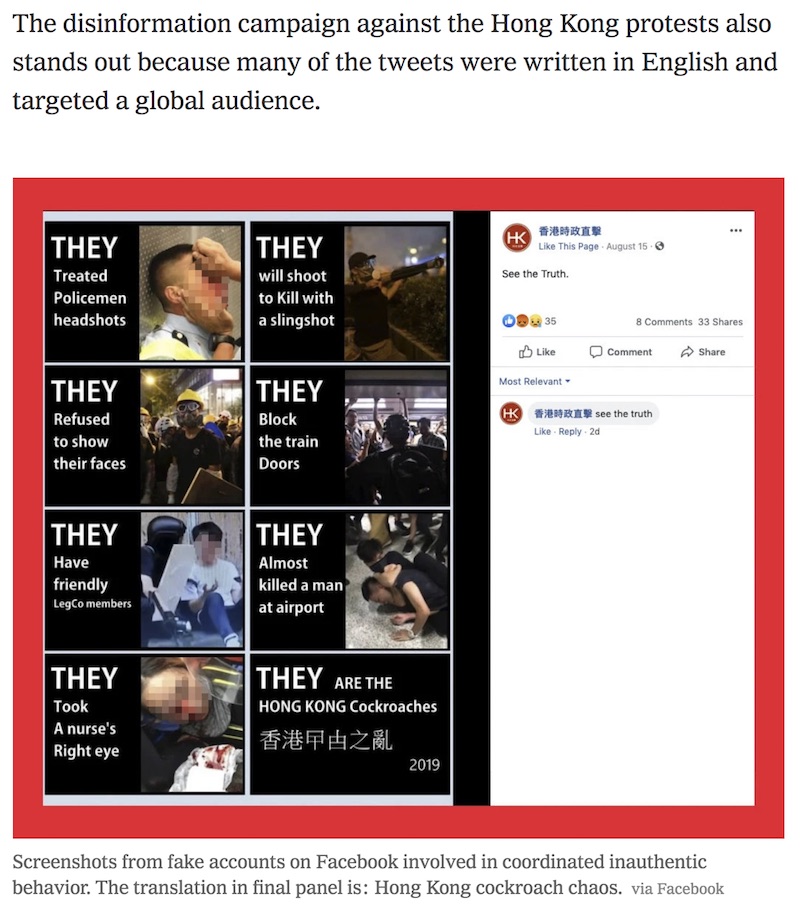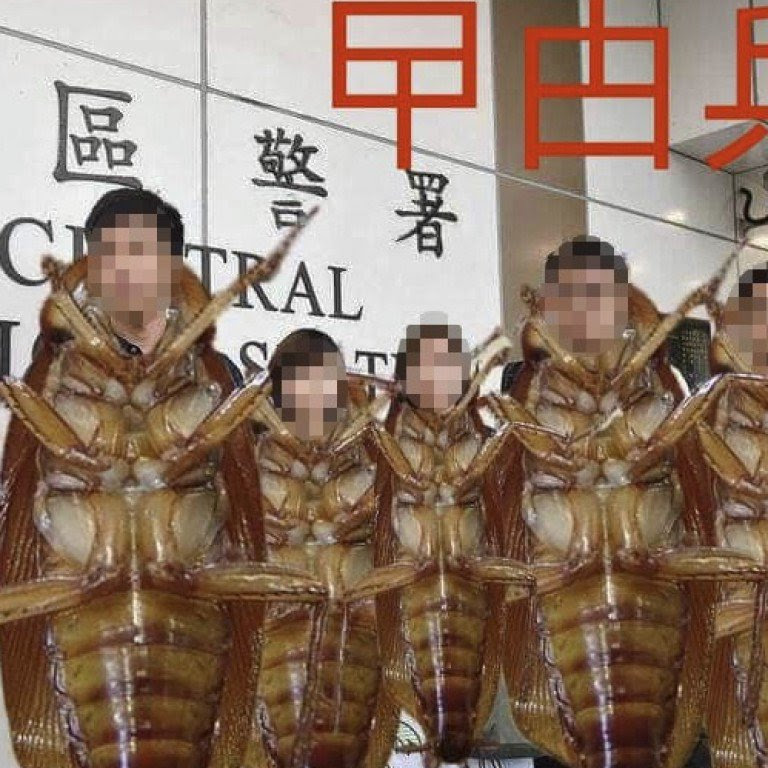Cockroach protesters
« previous post | next post »
The world has been convulsed this week by the news that China (where all such American social media platforms are outlawed) has been using hundreds of fake Facebook and Twitter accounts to spread gross disinformation about the Hong Kong extradition bill protesters:
"Facebook and Twitter Say China Is Spreading Disinformation in Hong Kong", by Kate Conger, Mike Isaac, and Tiffany Hsu (New York Times, 8/21/19)
Here's an example of their dirty work from the Times article:
Most of the reprehensible actions attributed to the protesters by the prevaricators who concocted this outrageous slur are actually infamous deeds perpetrated upon the protesters by the police and triad (Chinese transnational organized crime syndicates) thugs and goons.
The only Chinese in this thoroughly malicious and mendacious post is at the bottom right:
Xiānggǎng yuēzhá zhī luàn
香港曱甴之亂
"Hong Kong's cockroach chaos"
The usual Sinitic term for "cockroach" is zhāngláng 蟑螂.
Here the dissemblers intentionally use the Cantonese term gaat6 zaat6*2 曱甴 for "cockroach". The two Sinographs used to write the word gaat6 zaat6*2 are special Cantonese characters. Most people are unable to type them, so netizens humorously substitute the nonsensical collocation jiǎyóu 甲由, which would be pronounced gaap3jau4 in Cantonese, to suggest the shapes of the special Cantonese characters.
So far as I know, this word gaat6 zaat6*2 曱甴 for cockroach exists only in southern topolects, e.g., Cantonese and Min.
Cf. Minnan ka-choa̍h / kǎ-choa̍h / ka-chōa; Teochew ga1 zuah8; Mindong gâ-săk / gáh-săk 虼蚻. Also in Indonesian as kecoak, kacoa and in Thai as gà-júua กะจั๊ว.
Here's another example of the crude attacks on the protesters by the forces arrayed against them (from "Hong Kong protests become flashpoint in information war between China and US", South China Morning Post, 8/20/19):
The dehumanization, indeed verminization, of the Hong Kong protesters — in the eyes of their opponents — make them fair prey for annihilation.
Readings
- "Cryptic, allusive messages from Hong Kong's wealthiest tycoon" (8/18/19)
- "Women's Romanization for Hong Kong" (8/17/19)
- "Simplified characters in Hong Kong police newsletter" (8/15/19)
- "'Come, comrades, over there!'" (8/9/19)
- "HK protesters' 'sign language'" (8/6/19)
- "Go protest on Causeway Road" (8/5/19)
- "'HKers add oil'" (8/3/19)
- "'Go Hong Kong!'" (6/12/19)
- "Hong Kong protesters messing with the characters" (7/28/19)
- "Graffiti correction" (7/26/19)
- "Hong Kong anti-China graffiti" (7/26/19)
- "The enigma of the black hands" (7/25/19)
- "Ich bin ein Hongkonger" (7/18/19)
- "Hong Kong counterprotestors, Mandarin honorifics" (6/30/19)
- "Alice Mak Addresses the Hong Kong Chief Executive with Vulgar Language" (6/24/19)
- "Hong Kong protest puns" (6/20/19)
- "Hong Kong protest slogan" (6/20/19)
- "Cantonese protest slogans" (10/26/14)
- "'Cantonese' song" (10/24/14)
- "The umbrella in Hong Kong" (10/19/14)
- "Translating the Umbrella Revolution" (10/3/14)
- "The backstory to seven of the most popular protest slogans in Hong Kong's Umbrella Movement" (10/23/14)
- "Google Translate sabotage" (6/14/19)
- "Freemocracy" (6/13/19)
- "'Go Hong Kong!'" (6/12/19)
- "Tiananmen protest slogan grammar puzzle" (6/4/19)
[Thanks to Valerie Hansen and Bob Bauer]


Tim Taylor said,
August 24, 2019 @ 4:58 am
The biggest cockroach of all is sitting in Zhongnanhai. Unfortunately it's also armed to the teeth.
Don't expect a happy ending.
Chau said,
August 24, 2019 @ 8:23 am
@ Victor Mair: “So far as I know, this word gaat6 zaat6*2 曱甴 for cockroach exists only in southern topolects, e.g., Cantonese and Min.”
Modern Greek κατσαρίδα (katsarída) ‘cockroach’ may also belong to this group. According to Wiktionary, it is derived from Koine Greek κανθαρίδα (kantharída) ‘wheat insect’, the accusative case of κανθαρίς (kantharís). (https://en.wiktionary.org/wiki/%CE%BA%CE%B1%CF%84%CF%83%CE%B1%CF%81%CE%AF%CE%B4%CE%B1) And, of course, we all know that English cantharides is ‘Spanish fly’.
[VHM UPDATE: This usage of various forms of the word "cockroach" to describe protestors (as well as identification with other verminous insects, such as locusts) is emerging from a state-driven propaganda campaign. We discussed this in a new article from Jamestown, published this past Friday (https://jamestown.org/program/chinese-covert-social-media-propaganda-and-disinformation-related-to-hong-kong/).]